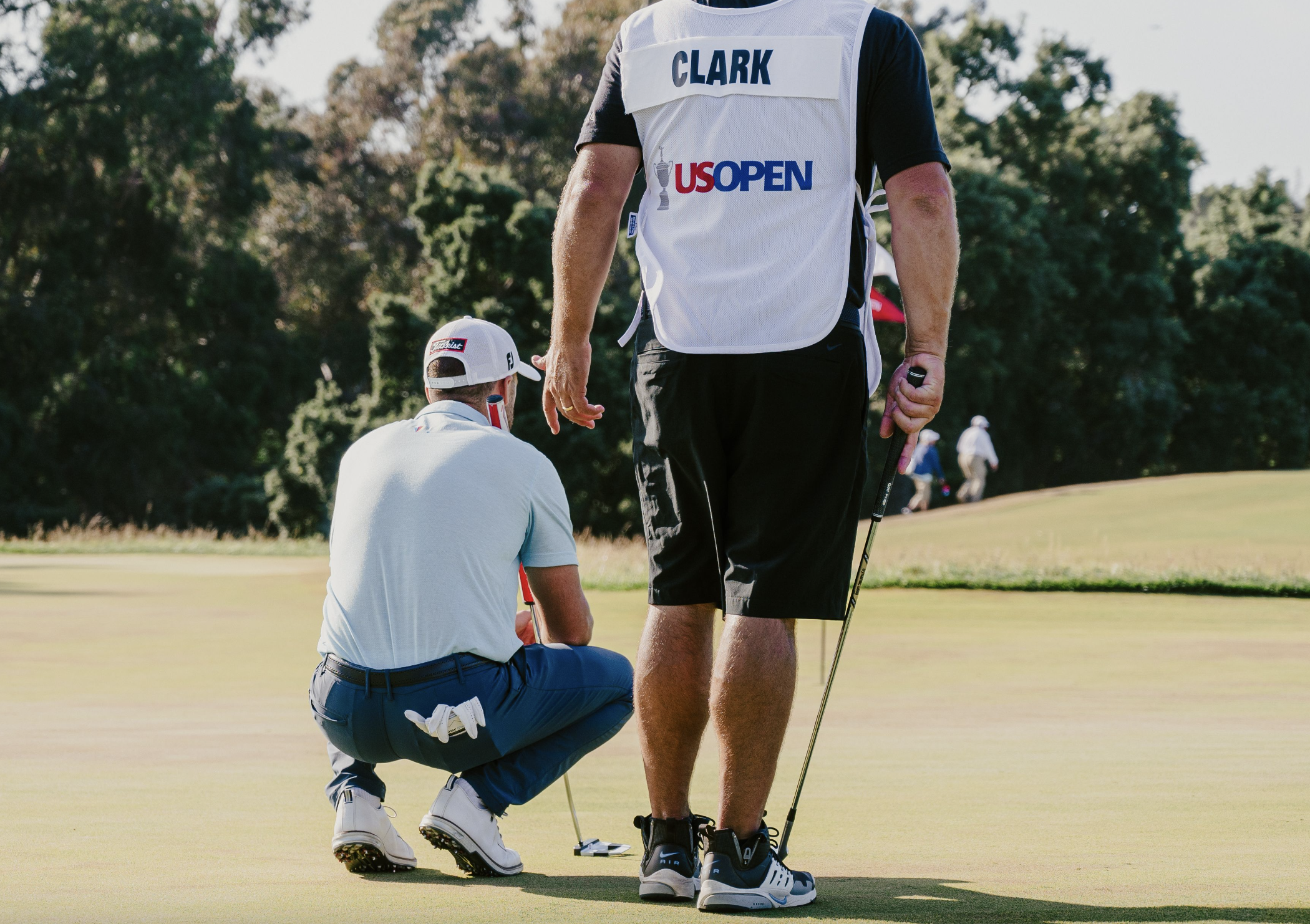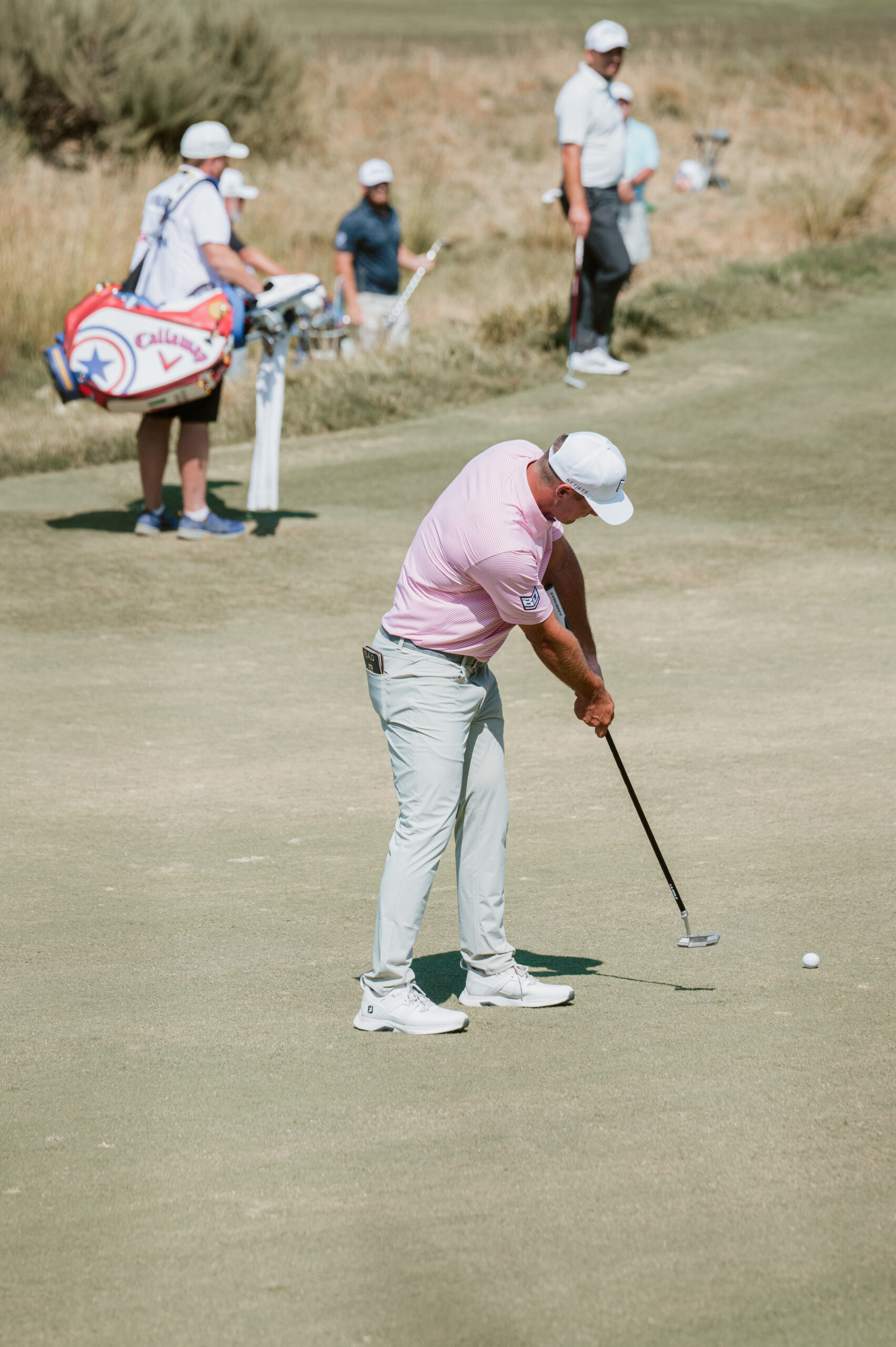A month ago, with the Ryder Cup teams undecided, I had a lot of questions. No, not so much about who would fill out the final few spots on Team USA, but rather why it seemed that so many of the Americans, locks and hopefuls alike, were using weird putters.
Rickie Fowler’s resurgent season—his first win on tour in more than four years and his strong T-5 showing at the U.S. Open—came with a visually jarring flatstick: the Odyssey Jailbird, an out-of-production zebra-striped mallet that he covered in lead tape and used along with a fat, 17-inch grip. Wyndham Clark won his first PGA Tour title and the U.S. Open with that very same putter. In a casual round at Medalist, Clark saw Fowler make everything with the new, counterbalanced mallet. He immediately contacted Odyssey and asked for a precise copy.
About a month after Clark’s surprise major win, Brian Harman won the Open, in part by rolling in an improbable number of long putts with a ghastly, massive, (also) out-of-production version of the TaylorMade Spider. Keegan Bradley, who became an outside contender for a captain’s pick, had his best season in over a decade using a version of the Jailbird with slightly different specs. Lucas Glover, whose struggles with the yips derailed his career for years, rode a broomstick putter made by the company LAB Golf to back-to-back tournament wins in August. The weird putter, seemingly, had made Glover into a dark horse candidate for Marco Simone.
Golf requires more equipment than nearly any other sport, and players make constant tweaks to clubs, balls, and even training aids. It is incredibly unusual when a club—like Henrik Stenson’s 3-wood or Brooks Koepka’s driving iron—stays in the bag for years at a time. Faces will cave in, grooves will wear down, new equipment will come along offering chances to get away with bad swings, and then the old clubs will stay at home. In the age of the launch monitor, golf clubs have become dispassionate tools.
The putter is the exception. Putters are magical. They are fickle. They are changed out seven times a week. They are kept in the bag forever. To put it less romantically: they are the focus of a lot of speculation. Data can tell pros something about a putter’s forgiveness or how well it is suited to a player’s stroke, but putting, for now at least, is still a lot about vibes.
And sometimes vibes can make people do weird things, like play a decade-old counterbalanced putter that isn’t even made by their club sponsor. Or: buy an expensive re-release of that same decade-old counterbalanced putter. The vibes were telling me, as the PGA Tour season came to an end, that this was the year of the unconventional putter. So, I tried to find out what that meant about golf, attachment to objects, and what people will (and won’t) do when certainty is just out of reach.
***
-

Wyndham Clark with his wand during a winning U.S. Open week. Photo: Fried Egg Golf
-

Wyndham Clark rolls one at LACC. Photo: Fried Egg Golf
-

Rickie and his Jailbird at LACC. Photo: Fried Egg Golf
“If we rewound the clock 50 years ago, we’d be asking the same questions as we’re going to ask 50 years from now,” the putting guru Brad Faxon told me. “When you go to some non conventional style, assuming you started conventionally, is [the benefit you get] placebo? Is it actually something that has to do with science?”
Faxon is one of the greatest putters that has ever lived and one of the most sought-after putting coaches in the world, but he is not cagey about the amount of mystery on the greens. He is regularly able to feel comfortable over the putter, to get into his flow state, to see the ball going in the hole. That’s why he is so in demand. But it is hard to know how much of that is teachable or transferable.
Obviously, pros don’t need to be sure that something will work to give it a try. That’s why there are so many instructors. And that’s why there are so many putters, too. High-level golfers will have garages full of flatsticks. Even I—a pretty stinky golfer—have more putters than I would like to admit.
“Does the putter matter? I played last week; I was over in Scotland for the Walker Cup. My clubs didn’t make it, so I had to borrow a set,” Faxon said. “The guys gave me a set, but everything was different, and the putter was a mallet rather than my blade. But I could still feel great over this putter. I felt like I didn’t have to do anything different, even though the entire look of it was different. The weights of it were different. The grip on it was different. Why can somebody adapt to that easier than others?”
That will likely remain an unanswerable question for a while longer. In the meantime, players will try anything in search of an edge, or so the thinking goes.
“Dustin Johnson would change seven putters between Monday and Wednesday, but he would always play either his Scotty Cameron or his black Spider,” Chris Trott, who worked on the PGA tour for TaylorMade for over a decade, told me. “But he would change the grip. He would change the loft. Sometimes he’d look at the insert. If he didn’t change the insert on the gamer, he changed it on other ones. It was all just part of his mojo to get him playing well.”
The thing is: there’s a difference between trying something in private and trusting it in public. Despite all the tinkering, when Thursdays rolled around, Johnson would always come back to the flatsticks that had been with him for longest. That’s what intrigued me about the year of the weird putter: players (Harman, who has used his oversized Spider for years, aside) were making big, visual changes and sticking with them. Why, now, were some players willing to leave their blades at home and replace them with putters that could attract ridicule?
Claret Jug secured, Brian Harman heads off to brand some English cattle with his putter. pic.twitter.com/TAFfQbmMJF
— Super 70s Sports (@Super70sSports) July 23, 2023
I can never tell if Brian Harman is using a comically large putter or if he's just really small so it looks bigger than it is pic.twitter.com/vkD10iQixU
— Zephyr Melton (@zephyrmelton) July 21, 2023
***
Stewart Hagestad is the man who seems like he has everything. He’s 6-foot-5 with a chiseled jaw and a big smile. He’s got a long, fluid, powerful swing. He is 32 and has a day job, but has played on four Walker Cup teams. Three weeks ago, he helped Team USA retain the cup at the Old Course. Two weeks ago, he won the U.S. Mid Amateur, his third title at that tournament, at Sleepy Hollow Country Club. Next year, because of that win, he’ll be in the field at the Masters, where he was the low amateur in 2017. There is just one thing about him that is maybe not so elegant: he uses a broomstick putter.
It has always been interesting to me how much aesthetics factor into putter choice. There is a baseline assumption in sports—that the only thing that matters is improving one’s odds of winning. Except that this is not entirely true. But I might look stupid is always part of the equation as well.
In 2011, when he was still playing college golf at USC, Hagestad was using a blade, a Scotty Cameron Newport, and he felt like everything on the greens was unfamiliar. His speed was off. His lines were no good. He wasn’t trying to make putts as much as he was hitting them and hoping they’d have a chance. He walked into a local golf shop determined to try something that would get him out of his funk. On a whim, he decided to make the biggest change possible, to putt with an entirely new motor skill. He started rolling putts with a Titleist Kombi, the only broomstick putter at the store. What did he have to lose?
Not much, evidently. He played that off-the-rack putter for six years, winning the 2016 Mid-Am with it and using it the next year at Augusta. Later in 2017, he switched to a different Titleist broomstick mallet, a prototype with no model name that was originally intended to be a backup putter for Adam Scott. Hagestad calls it his “baby.”
I wanted to know, though: even though the long putter had seemingly changed his career for the better, did he ever have regrets? Did the stigma of the strange object still linger despite its effectiveness as a tool?
“It would be a total lie if I told you no,” he said. “I can’t tell you how many snide remarks and comments that I’ve gotten on social media, let alone in person, about anchoring [or just using] a long putter. You name it.”
“There’s an ego that comes into this. There’s just certain personality traits that I’ve seen in the best athletes, certainly in golf,” Trott said. “They think: ‘I slip on a Superstroke grip, a few people notice. If I play a counterbalanced grip, it is what it is. If I go left hand low, no real problem. But if I go broomstick, there’s still a big stigma with that.’”
A mallet may have been a mark of shame before the explosion of the Odyssey 2-ball in the early aughts. But the broomstick is the final frontier. Even when players saw the flusher’s flusher, Adam Scott––as Trott put it, “this Adonis of a human”—using the broomstick, it did not catch on. It feels absurd to think of it simply: with millions of dollars on the line, players will still stay away from something that could make the game easier because they are afraid of looking silly.
Glover’s career changed when he switched to the long putter before the Memorial earlier this year. But, how many wins did he leave on the table because it was hard for him to get comfortable being The Man with the Broomstick?
***
Even new blade putters are often old. The most common blade shape used today, the Anser, was developed by Karsten Solheim in 1966. (Scotty Cameron’s Newport is very similar to this design.) Their alignment aids are visually smaller. The club twists more on impact. Modern woods and wedges have little resemblance to their mid-century counterparts. But the blade putter has endured even as it has competed with more technically advanced putters of all shapes. Why?
“That’s easy: Tiger Woods. How can Tiger Woods not impact our whole generation? Tiger Woods made Scotty Cameron without doubt.” said Trott. “Circle T is not Circle Tour. It’s Circle Tiger…They’ve just basically just got genius marketing. Genius.”
Circle Ts are Titleist’s rarest putters, named after the special logo they bear (it’s, well, a “T” inside a circle). They are made, mostly, for pros and elite amateur players. Each week a few are released to the public. (The vast majority of those putters are blades, perhaps reflecting the lack of public appetite for a hyper-expensive mallet.) Consumers enter a lottery to get an opportunity to purchase one for four figures. They never sit unsold.
The two most famous golf clubs in the world are both putters: Bobby Jones’s Calamity Jane and Woods’s Scotty Cameron Newport 2. A replica of the latter sold in 2021 for nearly $400,000. Calamity Jane, with her exaggerated offset and hickory shaft, is perhaps a bit impractical for modern use, but approximations of Woods’s putter are everywhere. Players from Scottie Scheffler to Brooks Koepka to Hideki Matsuyama game Cameron Newports while under equipment contracts with other companies. Jordan Speith, barely 30, has stuck with his nicked, discolored Titleist blade for well over a decade. The idea of the putter as an art object, as a partner that hovers above technological advances and contracts, comes from the fact that Woods has used the same putter, with only a few gaps, for nearly a quarter century.
“When I was going through junior golf, when you got a Circle T, it was like this ratification…you’ve been recognized as a good player,” Hagestad said of the Newport he received as a junior. “It’s special to me now for a very different reason than it was when I was 16. But you still remember those feelings.”
“Scotty Cameron is smart enough to know that there’s science behind the MOI and the sweet spot and everything about that with a bigger putter,” Faxon said. But, he points out: “I don’t think, ten years from now, that you’ll see Scotty Cameron or Bob Bettinardi collectible mallets.”
It seems a little absurd, the idea that the romance of a blade putter would convince players to leave strokes and sponsorship dollars on the table. But, often, seemingly, vibes prevail. “I have built putters to fit the personality as often as I have built them to the technique,” somebody who makes putters for tour players told me.
Perhaps there is just enough ambiguity in the world of putting that players can allow sentimentality to prevail over pure result-seeking. In the absence of indisputable data, they are given some permission to believe something sexy: that the putter chose them.
***
-

Stewart Hagestad at the 2023 U.S. Mid-Am. Photo: Kathryn Riley/USGA
-

Keegan Bradley's aimpoint routine. Photo: Fried Egg Golf
-

Bryson DeChambeau and his armlock method. Photo: Fried Egg Golf
When a player succeeds on tour, everything around them becomes popular. When one player wins with a Trackman, every player on tour (and many that aren’t) starts using a Trackman. When Bryson DeChambeau wins the U.S. Open after chasing distance, even Rory McIlroy tries to follow him down the speed training path. Every player is trying weird things to look for an edge. This is true on tour and in the golfing public at large. And as trusting as some players might be of their normal putters come tournament time, they are always tinkering at home, surely with broomsticks or armlock grips or, perhaps, an Odyssey Jailbird.
But, now, more of those putters are finally starting to see the light of day. It’s possible to see this as a revolution, or a precursor to one—the dam of convention finally cracking. Or, maybe, it’s just players starting to attach the same tales to new instruments.
The putter is about feelings and choices; shallow fears and fantastical stories. It’s ironic that in a sport so focused on swing paths and spin rates and ball speed, that the final stage of the game, the phase debatably most responsible for determining score, is largely about faith.
On the first day of Travelers Championship in June, Bradley apparently literally bowed to his Jailbird as he rolled in putt after putt en route to a win. “We bow to the putter,” he said after the round. “When it’s working, that’s our God.”


 by
by 
